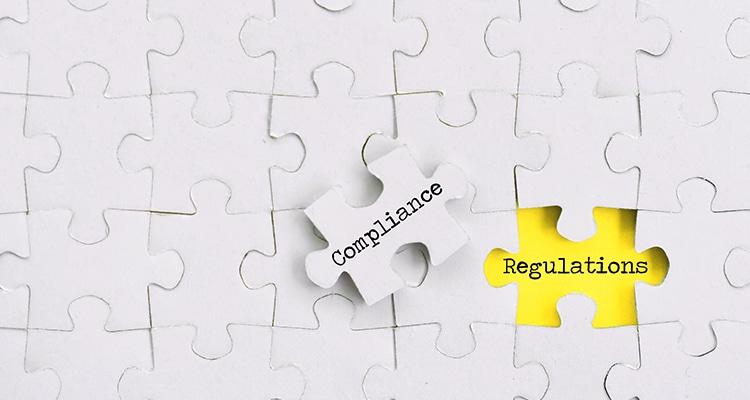Manufacturers failing to properly store, label correctly, and track chemical containers across plant floors are often at odds on where to start their Environmental, Health & Safety (EH&S) journey, specifically information management activities related to Environmental Management Systems (EMS) and Enterprise Resource Planning (ERP) platforms.
At a certain point in a manufacturer’s growth, leadership teams face a difficult decision that potentially increases risk and could impact productivity and costs. The choices are often opposing in nature: Either centralize EHS functions under an ERP software platform or implement a pure-play Software-as-a-Service (SaaS) EMS package.
Making the wrong choice can sometimes result in complex, costly software implementations that do not meet the needs of EH&S teams tasked with managing a safe workplace, and meeting regulatory requirements while at the same time maintaining an efficiently operating plant.
There is often a misconception that an ERP software platform should be able to manage every aspect of a company’s information. Implementing and activating an additional module for EH&S is just an added component.
However, this short-sighted approach may suggest that the company isn’t aggressively pursuing digital transformation and sustainability objectives – the hallmark of self-optimizing plants under Industry 4.0 or smart manufacturing.
A singular cloud platform for managing EH&S operations has several advantages over complex ERP enterprise systems that are examined below.
The Link Between OEE and Safe Chemical Operations
Industry 4.0. demands manufacturers exceed historical Overall Equipment Effectiveness (OEE) scores, typically measured at 60% efficiency, that show up in plants across the United States. OEE indicates the plant’s productivity and whether opportunities remain for improvement.1 The average score referenced above is influenced by the size of the manufacturer and the way plant operations work. Some may sacrifice speed for flexibility based on their business requirements and level of product customization.
This affects productivity and consequently their OEE score.
A higher OEE strongly correlates to a solid safety and environmental compliance culture and a willingness to implement digital EH&S KPI scorecards to measure improvement.
Generally, the manufacturers that reach scores of 90% or more have embraced plant floor initiatives to create a Unified Name Space (UNS).
A Unified Name Space is a software solution that acts as a centralized repository of data, information, and context where any application or device can consume or publish data needed for a specific action. This shared infrastructure or “smart floor” turns every piece of equipment into a data-sharing device enabled by sensors, the Industrial Internet of Things (IIoT), and plant historians (databases that collect time-stamped data). Retrieving this data from the edge involves a stack of existing technologies, including the Programmable Logical Controller/Human Machine Interfaces (PCL/HMI), Supervisory Control and Data Acquisition (SCADA), and Manufacturing Execution System (MES).
Leaders in Industry 4.0 are combining data from these operational technologies with existing IT software, including EH&S, CRM, and ERP platforms.
Machine learning and artificial intelligence then analyze the influx of big data to implement predictive maintenance models to reduce unplanned shutdowns. These, in turn, reduce potential worker safety and environmental incidents.
These models are so successful that manufacturers with a 90% OEE experience, on the average, just 2% of unscheduled downtime. Further, they also stimulate sustainable supply chains, striving to reduce chemical waste and predict (and prevent) future chemical incidents.
Importantly, these manufacturers achieved an injury frequency rate of 0.05 percent, roughly 18 times lower than those operating at 60%.
However, reaching this 90%+ OEE demands a high degree of digital transformation and a fundamental understanding of how EH&S fits into the software stack described earlier.
The Future Of Intelligent Manufacturing Is Decentralized
Understanding that the self-optimizing plant or intelligent factory strives to be decentralized is vital.
It turns every device, process, or software platform into a node that forms parts of the UNS. Industry 4.0, connected to the cloud, allows the plant to upgrade itself over time without creating a single point of failure typically found in centralized software systems.
Complex ERP software packages like SAP historically operate oppositely.
The mission of large ERP platforms is to become the entire system of record – driving finance, HR, manufacturing, supply chain, services, and procurement. Until recently, chemical EH&S were not typical functions found inside these massive, complex systems that, in many cases, are still completing their migration to the cloud.
However, recent acquisitions and the drive towards sustainability and Industry 4.0 have compelled these ERP platforms to add chemical EH&S functions. Its attempt to become the sustainability control power for the plant floor is arguably an afterthought, with safety and environmental modules haphazardly added to the mix.
ERP EH&S functions lack the focused regulatory compliance features of an enterprise solution like Chemical Safety’s Environmental Management System (EMS). Pure-play EMS platforms such as chemicalsafety.com pick up where ERP platforms leave off: the ability to track chemical containers and related EHS data at the granular level that includes real-time quantities on hand and chemical usage rates. They also include mobile apps for tracking hazardous materials across the factory floor on the spot, allowing a high degree of control and visibility in chemical safety.
ERP Platforms Risk a Single Point of Failure
The drive toward centralizing plant operations under one ERP package has resulted in costly mistakes, impacting large enterprises deramatically. Choosing an ERP software platform to drive chemical inventory tracking, including SDS and GHS labeling, also risks creating a single point of failure for an organization. Studies suggest the ERP failure rates may be as high as 75%, jeopardizing digital transformation programs under Industry 4.0.
Revlon’s stock dropped nearly 7% when it reported shipping delays and lost sales due to production stoppages at its North Carolina plant. The inability to manufacture certain goods or fulfill orders stemmed from a failed implementation of a leading ERP platform. Further, it could not complete regulatory reporting in both a timely and accurate manner.
Hershey suffered an even worse experience. An over-ambitious attempt to centralize IT and operational functions under one ERP rendered it incapable of processing $100 million of orders even though inventory was available. Quarterly profits declined by 19%, while the stock lost 8% of its value.
In both instances, management teams and staff were distracted from other priorities. Key areas were neglected including optimizing safety around chemical inventory and hazardous waste management. Further, it constrained the 90% OEE objectives typically demanded of industry leaders under smart manufacturing or Industry 4.0.
Advantages Of a Dedicated SaaS EMS Platform
In stark contrast, a dedicated EH&S SaaS platform like Chemical Safety’s EMS Software cloud platform provides a suite of focused modules with a singular purpose to help a company make chemical operations safer.
These include but are not limited to GHS Labeling, Safety Data Sheets, Chemical Inventory Tracking, Hazardous Waste Management, Environmental Regulatory Reporting, real-time chemical risk assessment and Employee Workplace Safety & Compliance.
Chemical Safety’s EmS open architecture via Application Data Interfaces (API) fully supports a decentralized UNS model under Industry 4.0. It allows integration with leading ERP software focusing on purchasing and supply side management. The Chemical Safety enterprise platform can also dynamically populate employees from the ERP human resource module into its system as mobile users. Any software linked to Industry 4.0, including asset optimization or process simulation software (Digital Twins), can bi-directionally interface with Chemical Safety’s cloud platform.
These collaborative features will allow self-optimizing plants to extract data in new ways to improve occupational and process safety from the underlying EH&S enterprise software.
Savvy EH&S leadership teams will appreciate the simplicity of keeping EH&S functionality separate from a bloated ERP package under emerging Industry 4.0 frameworks.
There may be little choice: Achieving a 90% OEE will become increasingly dependent on a decentralized factory floor. ERP adds risk to safe chemical operations through its quest to become the central nervous system or hub for best-in-class manufacturers.
The future of intelligent manufacturing and a Zero Harm Workplace sees software packages like Chemical Safety’s EH&S platform as an important node in a much larger data ecosystem.
In contrast, ERP risks becoming a single point of failure by attempting to become the center of the universe for all enterprise operations, including chemical safety. Using one single software platform for maintaining HR, accounting, inventory tracking, shipping, customer relationship, and customer relationship is challenging enough. Adding chemical safety operations to the ERP platform creates unnecessary risk, cost and complexity to the equation ultimately resulting in failure.



